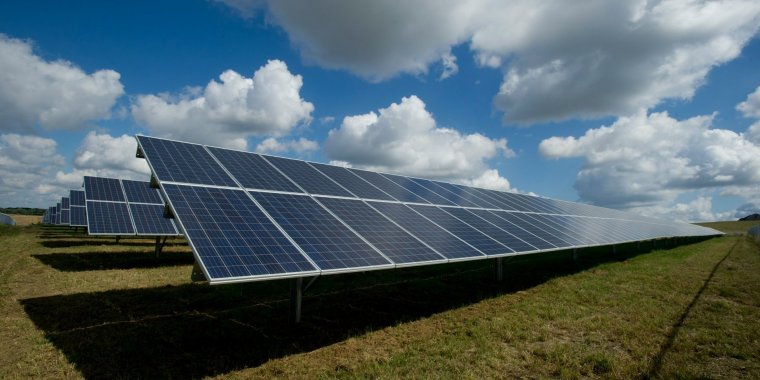| Technology |
The cost of solar power: how low can we go?
Although it may feel as if the news around climate change is unrelentingly negative, there are some remarkably bright spots. One of the brightest is solar energy.

Solar cells. Photo: American Public Power Association/Unsplash
In just the last ten years, the cost of solar cells has fallen by 90%. Over four decades, solar has transformed from one of the most expensive electricity sources to the cheapest in many countries.
To implement and expand solar energy worldwide, we need to make it cheaper and more efficient than silicon, the dominant material used for solar cells today.
One way to do this is to make solar cells from materials that can use more of the solar spectrum than silicon can, which would make them more efficient.
The most promising replacement for silicon is a family of materials called perovskites. Perovskites are cheaper than silicon and make excellent solar cells: their overall energy output can often meet or – in the case of multi-layered ‘tandem’ devices – exceed that of traditional silicon solar cells. However, they are not yet stable enough to operate at high performance for many years.
In his lab at Cambridge’s Department of Chemical Engineering and Biotechnology, Professor Sam Stranks is studying how perovskites degrade over time, to improve their efficiency and stability.
Stranks’ team uses specialised microscopy techniques to study defects in the perovskites, enabling them to get highly detailed pictures at the micro- or even the nanoscale.
They also simulate how perovskite devices work under sunlight, testing them continuously for thousands of hours under artificial sunlight, or under high-stress conditions by increasing temperature or humidity levels. These tests help them understand how and when the devices break.
These results are then taken back to their fabrication lab, where changes can be made to the composition of the materials, or how they are layered, to improve performance.
“Because perovskite devices are much cheaper to produce, they may not need to have as long a lifetime as their silicon counterparts to enter some markets,” said Stranks. “But to fulfil their ultimate potential, perovskite solar cells will need to reliably operate for at least a decade or more.”
One of the curiosities of perovskites is their ‘messy’ structure, which is very different from highly ordered silicon crystals. This messiness causes defects in the material that lead to tiny ‘traps’, which typically reduce performance.
In a 2022 paper, Stranks and his co-authors showed that these traps could hold the key to improving the longevity of perovskite solar cells. Even with the traps, perovskites show a similar efficiency to silicon.
But by tuning the chemical composition, and how the perovskite film forms, Stranks and his colleagues showed that it’s possible to prevent the formation of some of these traps.
Their results suggested that it’s possible to improve the efficiency of perovskites even further while improving longevity, opening the door to commercial production of perovskite solar cells.
Perovksites are prepared in liquid ink that is simply printed to produce a thin film of the material.
Printing perovskite solar cells onto flexible or even transparent materials at scale could open up a huge range of applications, such as transparent sheets that could be layered on top of silicon solar panels, solar cells that could be wrapped around buildings or on top of cars, or rolled out like a spool, reducing installation costs of rooftop solar power.
“Another strength of perovskite devices is that they can be made in countries where there’s no existing infrastructure for processing silicon,” said Stranks.
“Silicon solar cells are cheap in the long term, but require a substantial initial capital outlay to begin processing. But for perovskites, because they can be printed so easily, using far less material, you lower that initial cost. They offer a viable option for low- and middle-income countries looking to transition to solar energy.” (University of Cambridge)
YOU MAY ALSO LIKE





